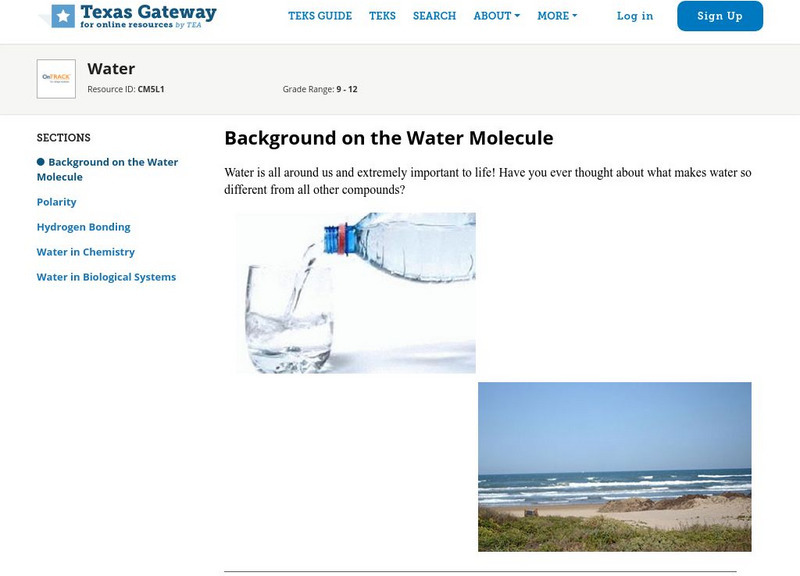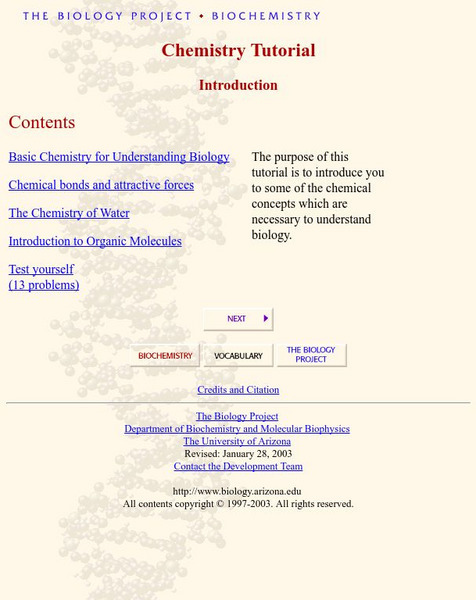Hi, what do you want to do?
Kenan Fellows
Unit 2: DNA Analysis
Ever wonder how they solve those mysterious murders in TV crime dramas? The second of four units in a Biotechnology series introduces scholars to the many methods of DNA analysis. Pupils create and run their own gel electrophoresis...
Kenan Fellows
Unit 1: Introduction to Biotechnology
Biotechnology is big! Introduce the uses of biotechnology to science scholars with a fascinating, fact-filled unit. The first installment in a series of four biotechnology units covers the role biotechnology plays in human and...
Georgia Department of Education
Ga Virtual Learning: Biology: Biological Molecules
Through informational text, interactive activities, step-through animations, and video clips, studnet explore biochemistry and the molecules that make up living things.
Vision Learning
Visionlearning: Biological Molecules: Fats and Proteins
An explanation of the importance of fats and proteins in the human diet. Examples of chemical structures of various fats and proteins are used.
Vision Learning
Visionlearning: Biological Molecules: Lipids
Lipids are defined. Chemical structures are used to demonstrate that fats and oils store energy.
CK-12 Foundation
Ck 12: Episd: First Organic Molecules
[Free Registration/Login may be required to access all resource tools.] Take a look at the groundbreaking organic molecules formed millions of years ago. Study the RNA that might have been that first organic molecule. In Earth's early...
CK-12 Foundation
Ck 12: Organic Molecules & the Miller Urey Experiment
[Free Registration/Login may be required to access all resource tools.] Examines how the first organic molecules were formed. The experiment of Stanley Miller and Harold Urey is explored along with the RNA world hypothesis.
Concord Consortium
The Concord Consortium: What Are Proteins and How Do They Fold Into Biologically Important Shapes?
In this learning module from The Concord Consortium, students will investigate how polar and nonpolar regions in big molecules interact to result in certain shapes and properties for those molecules.
University of Arizona
University of Arizona: Using Computers to Study Molecular Structure
The main objective for this exercise is to enhance your study of the properties and structures of biological molecules with modern computer graphics. Rather than passively viewing illustrations of molecular structure as they occur in...
Georgia Department of Education
Ga Virtual Learning: Ap Biology: Chemistry of Life
Through informational text, interactive activities, animations, and video clips, students examine the chemistry of living things, and they learn how interactions from atoms are fundamental to life as we know it.
Concord Consortium
Concord Consortium: Molecular Workbench Showcase: The Tree of Life's Molecules
Explore macromolecules and the smaller molecules that make up living organisms in this module.
CK-12 Foundation
Ck 12: Biology: First Organic Molecules
[Free Registration/Login may be required to access all resource tools.] Examines how the first organic molecules were formed.
Vision Learning
Visionlearning: Biology: Dna Ii: The Structure of Dna
Instructional module focusing on the physical structure of DNA. Discussion incorporates the description of the nucleotides, base pairs, and the double helix shape of a DNA molecule. Site also includes an interactive practice quiz and...
University of Arizona
Ua: Chemistry Tutorial
This general tutorial begins with an explanation of the polarity of the water molecule and the effects this polarity has on the properties of water. Goes on to introduce organic molecules and has a thourough tutorial on the third page.
Concord Consortium
How Are Interactions With Water Important for Maintaining My Life?
An investigation of how polar and nonpolar interactions affect shapes of biological molecules and their function. Modules explore the following: 1. Why don't oil and water mix? 2. Can a substance dissolve in both a nonpolar and a polar...
Macmillan Education
W.h. Freeman Publishing: Allosteric Regulation of Enzyme
Reactions in cells must be regulated and one way to do this is using allosteric molecules. These regulators can activate enzymes or inhibit them. This tutorial explains exactly how allosteric regulation works using words, narration, and...
University of Arizona
The Biology Project: Photosynthesis Problem Set Light Reaction
Problem set tests understanding of Photosynthesis by providing multiple choice questions accompanied by related tutorials. Problem set 1 focuses on light and role of pigments.
CK-12 Foundation
Ck 12: Biology: Glucose and Atp
[Free Registration/Login may be required to access all resource tools.] Overview of glucose and ATP.
CK-12 Foundation
Ck 12: Biology: Water and Life
[Free Registration/Login may be required to access all resource tools.] Covers the structure and properties of water.
CK-12 Foundation
Ck 12: Biology: Calvin Cycle
[Free Registration/Login may be required to access all resource tools.] Describes the Calvin cycle, the second stage of photosynthesis.
Texas Education Agency
Texas Gateway: Water
Given scenarios, descriptions, or illustrations, the student will determine the properties of water that affect chemical and biological systems.
University of Arizona
University of Arizona: Chemistry Tutorial
The purpose of this tutorial is to introduce you to some of the chemical concepts which are necessary to understand biology. Concepts include the basics for understanding biology, chemical bonds and attractive forces, the chemistry of...
CK-12 Foundation
Ck 12: Life Science: Organic Compounds
[Free Registration/Login may be required to access all resource tools.] The main chemical components of living organisms are known as organic compounds and are built around the element carbon. Living things are made up of very large...
Sophia Learning
Sophia: Diffusion: Lesson 1
This lesson explains the process of diffusion. It explains how diffusion is a passive form of transport, used to move molecules down their concentration gradient. It is 1 of 8 in the series titled "Diffusion."



























